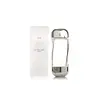What's inside
What's inside
 Key Ingredients
Key Ingredients

 Benefits
Benefits

 Concerns
Concerns

No concerns
 Ingredients Side-by-side
Ingredients Side-by-side

Water
Skin ConditioningDipropylene Glycol
HumectantGlycerin
HumectantPEG/PPG-14/7 Dimethyl Ether
Skin ConditioningTranexamic Acid
AstringentPEG/PPG-17/4 Dimethyl Ether
Skin ConditioningSorbitol
HumectantPhenoxyethanol
PreservativeDisodium EDTA
Citric Acid
BufferingDipotassium Glycyrrhizate
HumectantPPG-13-Decyltetradeceth-24
EmulsifyingPolyquaternium-51
Skin ConditioningButylene Glycol
HumectantSodium Citrate
BufferingPotassium Ascorbyl Tocopheryl Phosphate
AntioxidantSodium Metabisulfite
AntioxidantSodium Acetylated Hyaluronate
HumectantPaeonia Albiflora Root Extract
Skin ConditioningRosa Canina Fruit Extract
AstringentOriganum Majorana Leaf Extract
AntiseborrhoeicRubus Suavissimus Leaf Extract
Skin ConditioningTocopherol
AntioxidantBenzoic Acid
MaskingWater, Dipropylene Glycol, Glycerin, PEG/PPG-14/7 Dimethyl Ether, Tranexamic Acid, PEG/PPG-17/4 Dimethyl Ether, Sorbitol, Phenoxyethanol, Disodium EDTA, Citric Acid, Dipotassium Glycyrrhizate, PPG-13-Decyltetradeceth-24, Polyquaternium-51, Butylene Glycol, Sodium Citrate, Potassium Ascorbyl Tocopheryl Phosphate, Sodium Metabisulfite, Sodium Acetylated Hyaluronate, Paeonia Albiflora Root Extract, Rosa Canina Fruit Extract, Origanum Majorana Leaf Extract, Rubus Suavissimus Leaf Extract, Tocopherol, Benzoic Acid
 Reviews
Reviews

Ingredients Explained
These ingredients are found in both products.
Ingredients higher up in an ingredient list are typically present in a larger amount.
Butylene Glycol (or BG) is used within cosmetic products for a few different reasons:
Overall, Butylene Glycol is a safe and well-rounded ingredient that works well with other ingredients.
Though this ingredient works well with most skin types, some people with sensitive skin may experience a reaction such as allergic rashes, closed comedones, or itchiness.
Learn more about Butylene GlycolDipropylene Glycol is a synthetically created humectant, stabilizer, and solvent.
This ingredient helps:
Dipropylene glycol is technically an alcohol, but it belongs to the glycol family (often considered part of the ‘good’ alcohols). This means it is hydrating and gentle on skin unlike drying solvent alcohols like denatured alcohol.
As a masking agent, Dipropylene Glycol can be used to cover the smell of other ingredients. However, it does not have a scent.
Studies show Dipropylene Glycol is considered safe to use in skincare.
Learn more about Dipropylene GlycolDisodium EDTA plays a role in making products more stable by aiding other preservatives.
It is a chelating agent, meaning it neutralizes metal ions that may be found in a product.
Disodium EDTA is a salt of edetic acid and is found to be safe in cosmetic ingredients.
Learn more about Disodium EDTAPhenoxyethanol is a preservative that has germicide, antimicrobial, and aromatic properties. Studies show that phenoxyethanol can prevent microbial growth. By itself, it has a scent that is similar to that of a rose.
It's often used in formulations along with Caprylyl Glycol to preserve the shelf life of products.
Sodium Acetylated Hyaluronate is a type of Hyaluronic Acid.
Hyaluronic Acids help moisturize, soothe, and protect the skin.
Read about common types of Hyaluronic Acid here:
Sodium Hyaluronate
Hydrolyzed Hyaluronic Acid
Hyaluronic Acid
Water. It's the most common cosmetic ingredient of all. You'll usually see it at the top of ingredient lists, meaning that it makes up the largest part of the product.
So why is it so popular? Water most often acts as a solvent - this means that it helps dissolve other ingredients into the formulation.
You'll also recognize water as that liquid we all need to stay alive. If you see this, drink a glass of water. Stay hydrated!
Learn more about Water